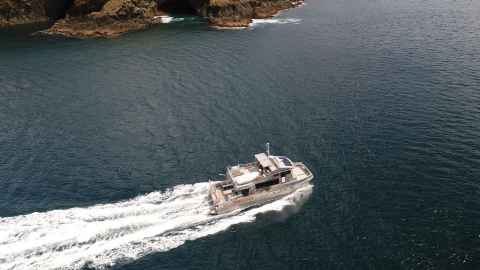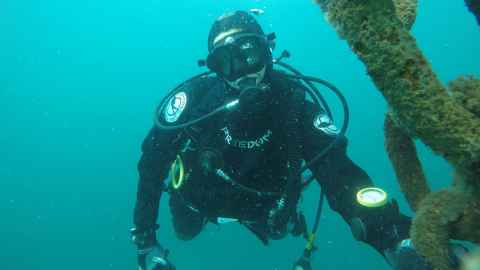University of Auckland researchers making waves to help save our oceans
8 June 2024
It's World Ocean Day. For University of Auckland researchers tackling the challenges facing our marine environment, that's also every day.

New Zealand has about 18,000 kilometres of shoreline, with more than 300 estuaries or harbours, plus an exclusive economic zone that measures 1.3 million square nautical miles. So on World Ocean Day we look at some of the work being tackled by our researchers to help restore and preserve the marine environment.
Professor of Marine Science Simon Thrush is the director of the University of Auckland’s Marine Science Centre. He says: “We’re very closely tied to our coastal oceans culturally, recreationally and economically, we see value in the natural environment, and for many people, the best chance we have to easily get into nature is to dive into the water.”
In 2023, the University launched a multi-million-dollar marine research vessel, Te Kaihōpara, as part of its commitment to marine conservation and research in Auckland’s Hauraki Gulf.
Associate Professor of Marine Science Nick Shears says the 15.9m catamaran supports many research activities including scientific diving.
“It provides us with access to the offshore islands at a time when we are seeing unprecedented changes in the Hauraki Gulf. The offshore islands are important to see what’s happening.”

Mussel and seaweed farming
A collaborative research project by the University of Auckland and the University of New England has shown environmental gains from aquaculture are possible.
The research assessed the diversity and abundance of wild fish and invertebrates on farms growing kelp and/or mussels compared to non-farmed sites in Auckland’s Hauraki Gulf and the Gulf of Maine in the US.
The research, which was supported by The Nature Conservancy in New Zealand and Maine, found mussel and seaweed farming has the potential to provide habitats for marine species, as well as providing food for people.
Professor Andrew Jeffs of the University of Auckland says the fish populations found on mussel and kelp-mussel farms in the Hauraki Gulf were equal to or greater than those at the non-farm sites, in both diversity and abundance.
Professor Jeffs says: “In an examination of gut contents of snapper living inside and outside New Zealand green-lipped mussel farms, fish living on the farm sites were also found to be eating more nutritious diets than those living in natural habitat.”
He says these results are a promising sign that mussel and kelp farms can provide both settlement and nursery habitat and an important source of food for wild fish species.
“When implemented in the right places, aquaculture could bolster biodiversity and contribute to the productivity of fisheries.”
The study is a first of its kind in New Zealand. Measuring habitat benefits in Maine and New Zealand will start to fill a critical gap in knowledge about the effects of seaweed and shellfish aquaculture on biodiversity in cold-water ecosystems.

The seaweed grew back naturally without anyone’s help; there was no need to ‘seed’ it. Simply removing the kina achieved so much.
Controlling kina
Dr Kelsey Miller is a marine scientist who led colleagues and supporters in hundreds of dives to remove kina (sea urchins) from the barrens on shallow rocky reefs in Auckland’s Hauraki Gulf during the spring and summer of 2020 and 2021.
When New Zealand’s Oceans and Fisheries Minister Shane Jones cites the presence of 400,000 kina on just 7.1 hectares of reef as an illustration of an “industrial-sized, industrial-grade” problem today, he’s talking about Dr Miller’s PhD project, which involved laboriously removing those urchins one by one.
She found removing kina was extremely effective in rapidly restoring lush forests of the brownish kelp Ecklonia radiata.
“That just wasn’t expected,” says Dr Miller. “The seaweed grew back naturally without anyone’s help; there was no need to ‘seed’ it. Simply removing the kina achieved so much.”
Now Dr Miller, a research fellow based at the University of Auckland’s Leigh Marine Laboratory, and Dr Nick Shears, who supervised her PhD, are advising policy makers, iwi, fishers and local communities on how best to tackle barrens.

Some experiments have shown that as much as 40 percent of the carbon released from the kelp forests in the dissolved form is long-lived.
Kelp forests
An area of research currently gaining momentum in the fight against climate change lies beneath the surface of our oceans.
Caitlin Blains, a research fellow in the University of Auckland’s Institute of Marine Science, has dedicated eight years of her career to researching seaweed and kelp forests. After spending two and a half years in freezing Atlantic waters studying the impact of a seaweed called Desmarestia on biodiversity, she came to New Zealand, to complete her PhD.
Her work at the Leigh Marine Lab initially focused on the impact of anthropogenic stressors on kelp forest function and productivity, mainly coastal turbidity. A side component of this work led her to carbon sequestration.
“As kelp photosynthesise, they draw down carbon into their tissues to grow, and they’re kind of like these conveyor belts that keep growing and continually sloughing off tissue as they grow,” she says.
Compared with terrestrial forests, where fallen leaves provide physical proof to account for carbon, it is much harder to identify what happens to carbon captured by kelp forests. This is because kelp grows on rock, so for the carbon to be sequestered, it has to be exported somewhere conducive.
Some experiments have shown that as much as 40 percent of the carbon released from the kelp forests in the dissolved form is long-lived. Caitlin compares this to other research on particulate matter, including her work, which measured around 10 percent of the tissue staying as an organic carbon that can be sequestered.
Kelp as nature’s solution to carbon reduction is a topic gaining attention outside of academia, with interest from government, community groups, and private industry, all looking to kelp for answers.
WORLD OCEAN DAY
Read more about World Ocean Day.
FOCUS ON OCEANS AT APRU EVENT 24-26 JUNE
The University of Auckland hosts the 28th Annual Presidents’ Meeting of the Association of Pacific Rim Universities (APRU) from 24 to 26 June. The theme is ‘The World’s Challenges Divide Us, the Ocean Currents Connect Us’.
APRU delegates from around the world will consider the impacts of climate change on oceans and the implications for communities and Indigenous populations, climate justice, food and water security. They will discuss the role the APRU members have in providing leadership on this challenge.
The APRU comprises leading universities from 18 economies of the Pacific Rim known worldwide for their academic and research excellence.
Professor Simon Thrush (Faculty of Science) and Associate Professor Dan Hikuroa (Faculty of Arts) will present lunchtime talks on their ocean-related research on Tuesday 25 June.
The Vice-Chancellor, Professor Dawn Freshwater, is the Vice-Chair of the APRU and will open and close the three-day event, as well as chair a panel discussion on 26 June on ‘Sea, Soil, Sustenance: Pathways to Resilient Food Systems’.
Media enquiries to mediateam@auckland.ac.nz